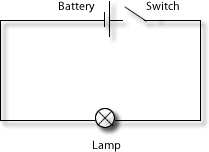Currents and Circuits
Take care
Electricity can be dangerous. You certainly don’t want an electric current to pass through you! Explore Ausgrid’s Learning resources1 or go straight to the Kids Safety Zone2. You could also explore Lesson 1 from Electric Kids3 to find some dos and don’ts about electricity. |
Create a circuitHow do we make electricity do useful work? We can use electricity to light a bulb, sound a buzzer, turn a motor or produce some heat. Experiment yourself by creating a circuit using components similar to those below, or use an online resource to find ideas for experiments.
You need to have the Flash Player4
installed and javascript enabled in your browser in order to view the activity.
|
Draw a circuit diagramElectricity needs a path to travel along. It needs to start from one place, move along the path, do the work we need it to and return to where it came from. These paths are called circuits. If you break the circuit, the electricity stops flowing. Could you draw the circuit diagram for the experiment on the left?
In this circuit, the lamp would not light up because the switch is open. Use straight lines to represent wires. There are special symbols to use to represent the power supply (the battery) and the lamp. |
|
What would happen if the switch were closed? What would happen if there were two lamps in the circuit? |
|
Links
- http://learnelectricity.ausgrid.com.au/
- http://www.ausgrid.com.au/Common/Education/Kids-safety-zone.aspx
- http://www.electrickids.com.au/lesson1.html
- http://www.adobe.com/


